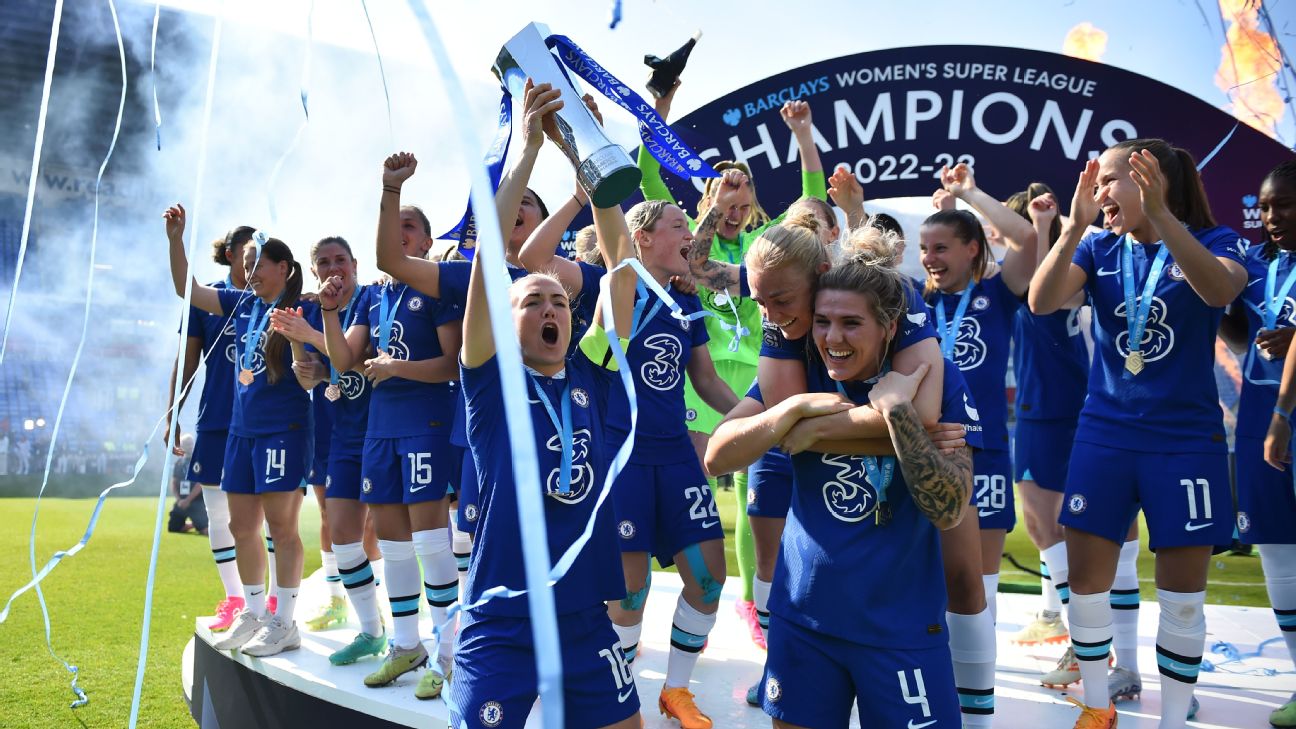What makes this WSL title different for brilliant, resilient Chelsea

Sophie Lawson reports from Reading as Chelsea sealed another WSL title. (1:23)
For the second year running it started with disappointment as Chelsea were dealt a loss in their opening game of the Women’s Super League season. This time, instead of a narrow and contentious defeat to title rivals Arsenal, it was a shock result against newly promoted Liverpool and three penalties going 2-1 in favour of the Reds.
For the five-time WSL winners, such alarm bells never sound very loudly and as Emma Hayes’ side have proved over the years, all that matters is how the season ends and who is top come that final whistle. So, an opening-day loss, even from the most unexpected of opposition, was nothing to worry about as the Blues ended up crowned champions yet again Sunday.
– Chelsea beat Reading, secure another WSL title
– Hamilton: Chelsea win WSL title amid Hayes’ ‘hardest year’
We are told week in, week out, that the WSL is the most competitive it has ever been, yet while this is the seventh straight season in which the title has gone down to the final day, it’s the sixth time Chelsea have been involved. Indeed, not since missing out on the title on the last day of the 2014 campaign have Chelsea failed to win on the last (official) day of matches.
Save for a handful of seasons that have seen the title sewn up with a fair number of games still to play, there is consistently little margin for error at the top end of the table, even if each season brings about the same old predictable drubbings against the weaker teams in the pack.
In many ways, 2022-23 was a season that followed the WSL script, with a last-day decider and the Blues victorious once again. But like snowflakes, fingerprints and boy bands, no two seasons were quite the same, not least with the increased improvements from Manchester United — it was their turn to push Chelsea all the way — rather than Arsenal or Manchester City.
Injuries, significant dips in form and fixture congestion kept the Blues’ sixth league title far from a certainty. Where Hayes’ side would have produced drubbings along the way to their silverware in previous years, they spluttered and stumbled this season. Before April, only one of their first 15 games — a comprehensive 8-0 win over a dilapidated Leicester City team — was won by a margin of more than two goals. Long-term injury layoffs to Fran Kirby and Pernille Harder saw the attack lose some of its lustre, and their focus switched: instead of attacking from the back, they were defending from the front.
It wasn’t just the players who were absent at key periods for the Blues: Hayes herself kept away from the pitch due to an emergency hysterectomy at the start of the season, and the touchline looked barren without the consistent, energetic presence of the 51-year-old. The manager would praise the technical staff during her leave, but it did feel at the time that her absence was the reason the champions lacked their usual resplendent Technicolor, fumbling through games in muted hues.
It became a season of grinding and labouring to wins that looked deceivingly comfortable on paper. It wasn’t until Chelsea got to the tail end of the season, when they played twice a week to complete all their games in hand due to competing in the Champions League, that the Blues began to show their best football. The late return of Harder from injury bolstered the attack as the Dane scored five times in the final five games, showing little sign of just how long she’d been out.
Suddenly, with a run of wins, Chelsea were chasing United down, turning a paltry goal difference to a handsome one until they overtook the team at the top, on points and on goal difference for good measure. And once again, at the all-important time of the season, it was Chelsea who were leading the way.
– Stream on ESPN+: LaLiga, Bundesliga, more (U.S.)
One of the stats released by Opta ahead of the last round of WSL fixtures caught the eye: Chelsea have made 80 changes to their starting XIs between league matches this season, 30 more than any other side in the WSL. In isolation, it looks like a show of strength and depth, yet the changes made by Hayes were rarely made on a whim. Hayes was purposeful in her planning to get the best out of the players available: her substitutions and rotations have been based around giving vital rest to the players that form the core of her title-winning team. She has balanced this by giving the right amount of playing time to those who’ve struggled through injuries as well as those new to the league, her focus always on the bigger picture where possible.
Against Reading on the last day of the season, we saw the same familiar labouring from Chelsea, who played the part of the dominant team lacking the spark that could have made the game a more comfortable one. But as always with the Blues, regardless of the opposition or the occasion, they rarely fail to deliver and the 3-0 win cemented them as champions again.